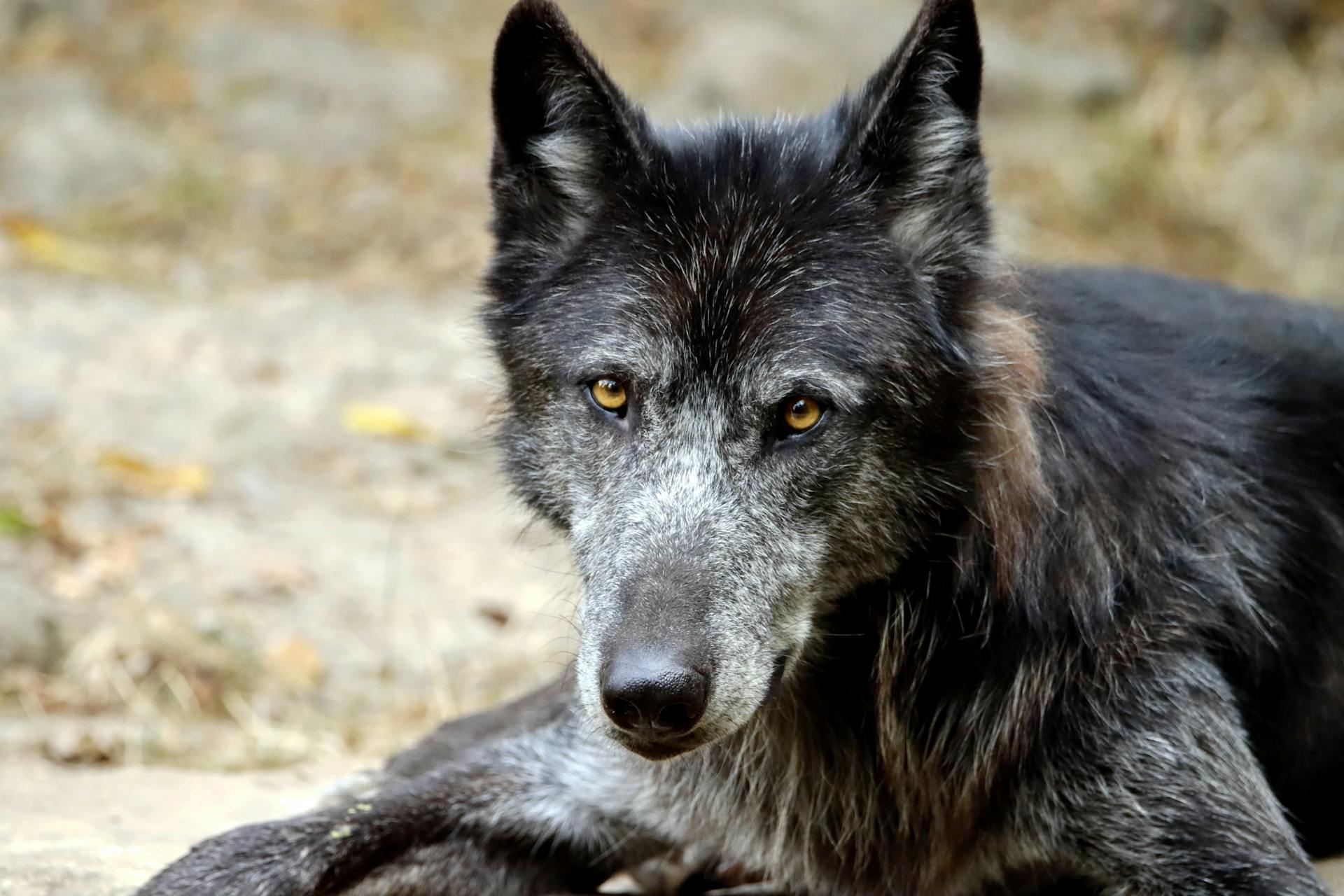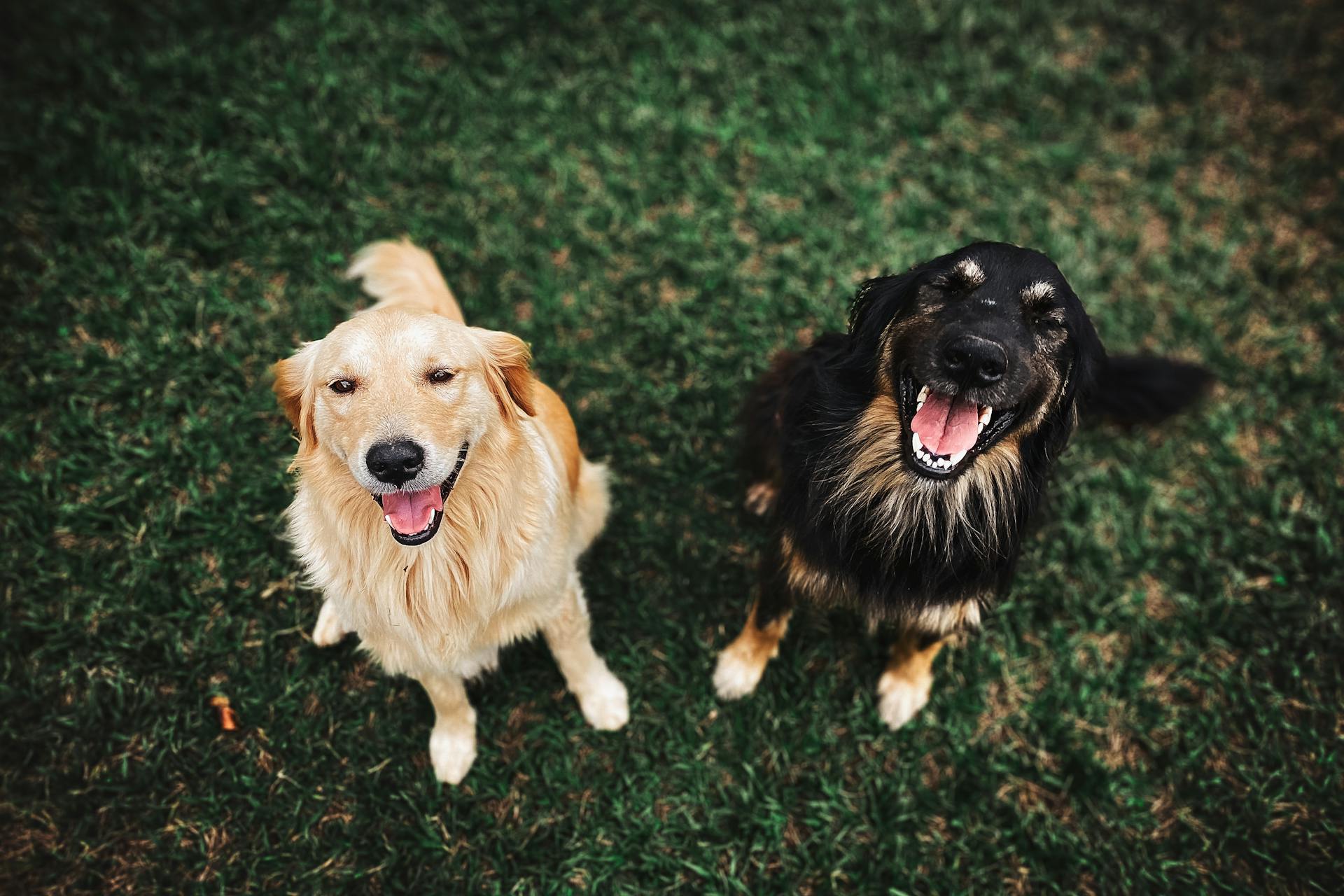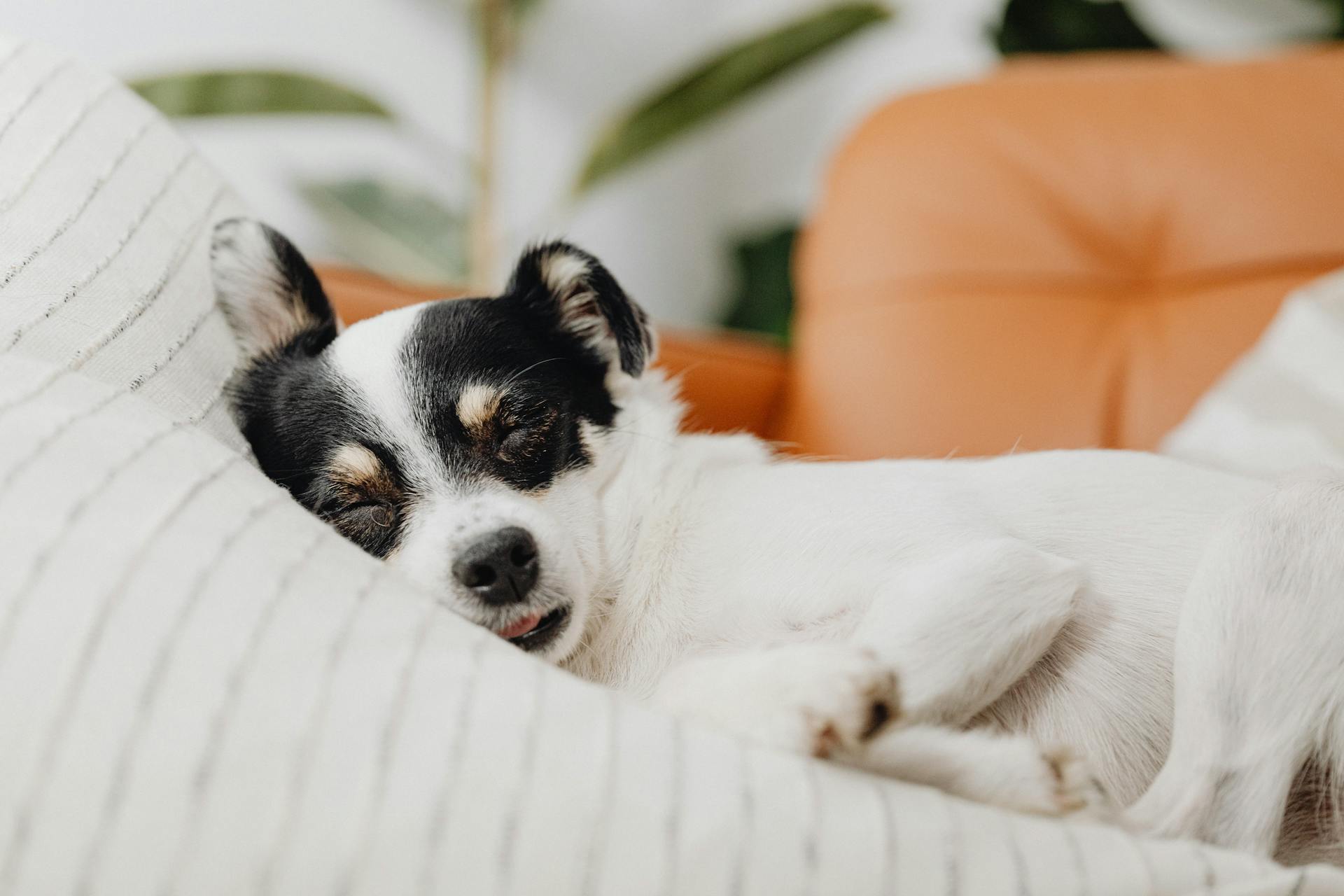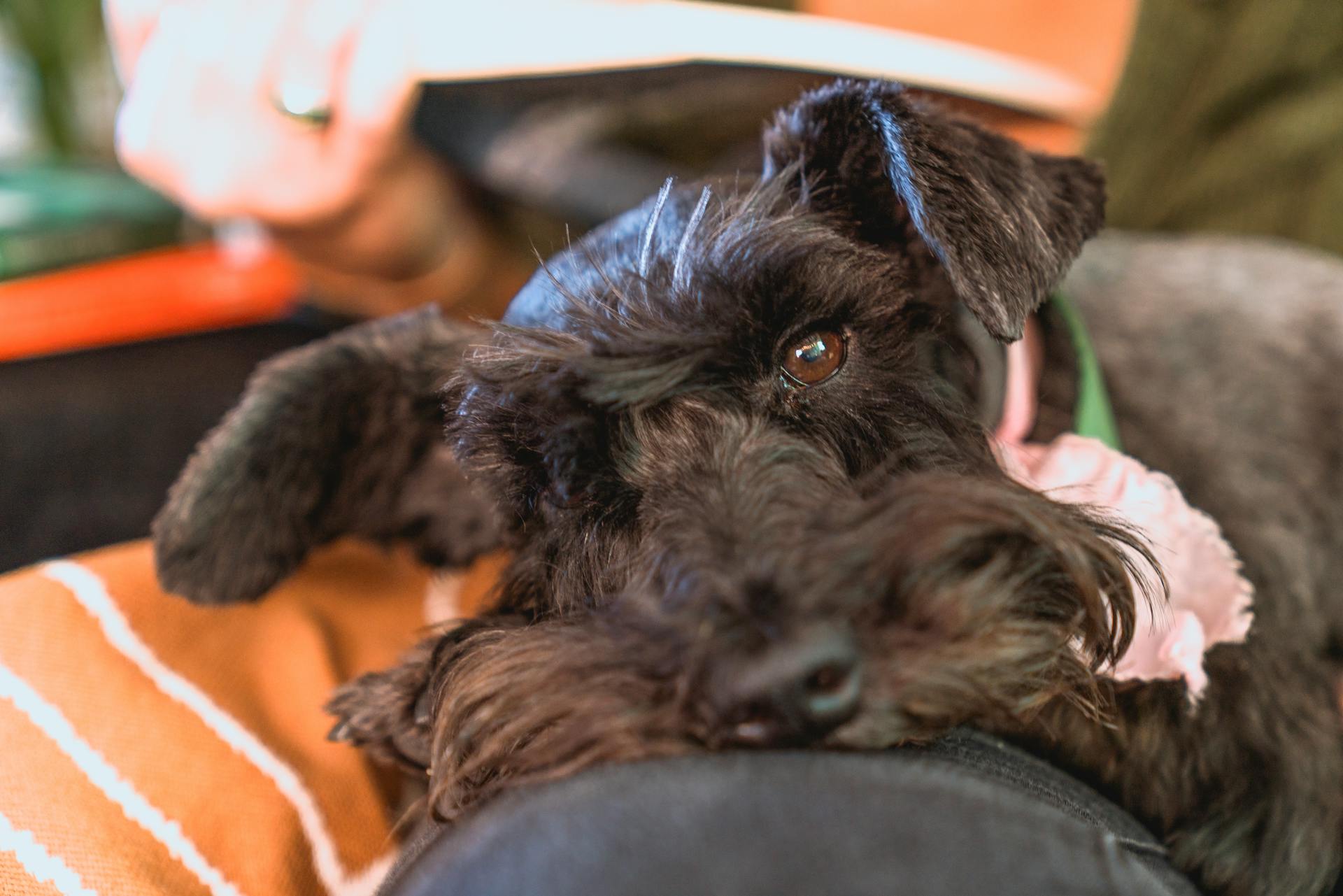
The Black Wolfdog is a unique and fascinating breed that has its roots in the crossbreeding of domestic dogs with gray wolves.
They are a hybrid of a domestic dog and a gray wolf, specifically a wolf that is a member of the Canis lupus species.
Their striking appearance is one of their most distinctive features, with a thick, double coat that can range in color from black to dark gray.
This coat helps to protect them from extreme temperatures and weather conditions.
Black Wolfdogs are highly intelligent and energetic animals, requiring regular exercise and mental stimulation to prevent boredom and destructive behavior.
They are also known for their strong prey drive and may not be suitable for homes with small pets.
Take a look at this: Domestic Dog That Looks like a Wolf
What Is a Black Wolfdog?
A black wolfdog is not a standardized breed, but rather the result of multi-generational selective breeding.
They're often the product of breeding a wolf dog with another wolf dog or a domestic dog.
The vast majority of wolf dogs are 2, 3, or 4 generations removed from a pure wolf.
This means their lineage includes one or more dogs between the pure wolf and the wolf dog.
As generations pass, the offspring become less wolf-like in appearance and behavior.
Black wolfdogs often exhibit physical characteristics resembling wolves, including a striking black coat.
They can be a mix of various breeds and types that showcase wolf-like features and a distinctive black pelts.
Some breeders crossbreed a wolf dog with a domestic dog, often using a breed like a German Shepherd or Husky.
Breed Overview
The black wolfdog breed is a remarkable companion for the right owner, known for its majestic appearance and deep-rooted loyalty.
Their complex needs require a committed, experienced handler prepared to provide ample space, proper training, and socialization.
Owning a black wolfdog comes with significant responsibilities, but for those ready to meet the challenges, it can be an excellent addition to their life.
Physical Characteristics
Black wolfdogs have large, erect ears and a bushy tail, giving them a distinctive appearance.
Their almond-shaped eyes are usually yellow, often encircled by a dark ring, and may range in shade from light yellow to amber. This striking feature is a key part of their unique look.
Black wolfdogs have a double coat, comprising two distinct layers: an outer coat of coarse, straight fibers and an inner undercoat with a soft, wool-like texture.
This double coat helps them thrive in harsh climates, keeping them warm in winter and cool in summer. Regular grooming is essential to keep their coat healthy and looking good.
Black wolfdogs typically stand between 26-34 inches tall, with average adult weights ranging from 60 to 120 pounds, depending on their lineage, breed, and hybrid composition.
A unique perspective: Minnesota Wolfdogs
Appearance
Black wolfdogs have large, erect ears and a bushy tail. Their almond-shaped eyes are often yellow and may range in shade from a light yellow to an amber hue.
Their striking black coat showcases various shades of ebony, making them easily recognizable. The double coat of a black wolfdog is made up of two distinct layers: an outer coat of coarse, straight fibers and an inner undercoat with a soft, wool-like texture.
Brushing their fur at least once a week helps keep their coat healthy and looking good, while also preventing mats and tangles. This regular grooming is especially important during shedding.
Weight and Size
Black wolf dogs have a slender, elongated frame that gives them a striking and impressive physique. This balanced gait is a testament to their well-built physique.
They can vary significantly in height, weight, and stance based on factors like their lineage, breed, and hybrid composition.
Lower content wolf dogs typically stand around 26-34 inches tall.
Average adult weights for black wolf dogs range from 60 to 120 pounds.
Behavior and Temperament
Black wolfdogs are intelligent canines that exhibit a keen curiosity and problem-solving skills, often displaying a desire to explore their surroundings. They form deep bonds with their human companions, making them devoted family members.
Their loyalty and affection are evident, but they may have an independent nature, reflecting their wolf ancestry. This can lead to behaviors that are different from traditional domestic dogs.
Black wolfdogs are generally not aggressive, but they may bark or growl if they sense danger. They tend to avoid confrontations and may flee from threats.
Temperament and Personality
Black wolf dogs are known to be intelligent and curious, often displaying problem-solving skills and a desire to explore their surroundings.
Their intelligence and curiosity make them engaging companions, but they also require regular exercise to keep both their bodies and minds engaged.
Black wolf dogs are typically energetic and need activities like long walks, interactive play, and mental challenges to thrive.
These dogs form deep bonds with their human companions, displaying loyalty and affection that makes them devoted family members.
However, their independent nature may lead to behaviors that are different from traditional domestic dogs, requiring a firm and consistent approach when it comes to training.
Black wolf dogs generally are not aggressive, but they may bark or growl if they sense danger, which is why they're not suited to be guard dogs.
Proper socialization during their early stages is vital for developing well-adjusted companions, comfortable around different people, animals, and environments.
Their loyalty and affection are fierce, which means they will fiercely protect those they love, making them great companions for dedicated owners.
Are Aggressive?
Black wolf dogs can feel uncomfortable and uneasy around unfamiliar people and surroundings.
They're more likely to run away than attack, which is a good thing to remember if you're considering bringing one home.
However, during the late fall and winter seasons, black wolf dogs with a high wolf content may display aggressive behavior due to hormonal changes known as winter wolf syndrome.
This is a natural response to the changing seasons, but it's essential to be aware of it to provide the best care for your black wolf dog.
Black wolf dogs can display aggressive behavior under certain circumstances, but it's not a guaranteed trait of the breed.
Care and Nutrition
Black wolfdogs require a high-protein and high-fat diet due to their large size and active lifestyle.
A raw diet can be a great choice for black wolfdogs, providing necessary nutrients in an easily digestible form. This type of diet should include 50% muscle meat, such as beef, chicken, or lamb.
Alternatively, a high-quality kibble diet with real meat and high protein content can also meet a black wolfdog's nutritional needs.
Take a look at this: Can You Own a Wolfdog
Diet and Nutrition
For a Black wolf dog, a high-protein and high-fat diet is crucial due to their large size and active lifestyle. A raw diet can be a great choice since it provides the necessary nutrients in an easily digestible form.
A high-quality raw diet should include 50% muscle meat, such as beef, chicken, or lamb. This will provide the protein and energy your Black wolf dog needs to stay healthy and active.
Raw bone is also essential in a wolf dog's diet, making up 25% of their daily intake. Beef, chicken, or lamb bones are all great options.
Expand your knowledge: High Content Wolfdog
Organ meat, including heart, liver, and kidney, should also be included in your wolf dog's diet, making up the remaining 25%. This will provide essential vitamins and minerals.
A high-quality kibble diet with real meat and high protein content can also meet a Black wolf dog’s nutritional needs, making it a more affordable option.
Back Exercise Needs
Black wolfdogs are high-maintenance pets that need a lot of exercise and mental stimulation.
They are happiest in environments where they have plenty of room to move around and explore.
Daily exercise sessions that include both physical activity and mental stimulation are crucial to their well-being.
Long walks, runs, playtime, and engaging activities like obedience training, puzzle toys, and interactive games are all great ways to provide exercise and mental stimulation.
Proper exercise is essential to prevent them from becoming destructive.
Their exercise needs can vary based on their individual traits, such as their content level (low, mid, or high), age, and overall health.
Our recommendation is to only purchase from a reputable wolf dog breeder who requires an interview process.
Cost
Purchasing a black wolf dog can be a significant investment. The initial cost can range from $1,000 to $3,000, depending on the pup's age and the breeder.
You'll also need to consider the additional expenses that come with owning a wolf dog. This includes food, vet visits, emergency plans, and a large outdoor enclosure.
A large outdoor enclosure is a must-have for a wolf dog, providing a safe space for exercise and play. This can be a significant expense, but it's essential for the dog's well-being.
The cost of caring for a wolf dog can add up quickly, so it's essential to be prepared for the financial commitment.
A different take: Czechoslovakian Wolfdog Cost
History and Origins
The black wolfdog's history is a fascinating story that spans thousands of years. The trait of having a black coat likely arrived in North America around 15,000 years ago.
Native Americans and Europeans used black wolf dogs as hunting companions, taking advantage of their unique abilities.
Genetic research has revealed that the dark coloration of black wolf dogs is the result of a mutation introduced through interbreeding with domestic dogs, specifically the "K locus" gene.
Wolf Origins and History
The black wolf dog's history is a fascinating one.
About 15,000 years ago, the trait likely arrived in North America through early immigrants.
Native Americans and Europeans used black wolf dogs as hunting companions, a testament to their intelligence and loyalty.
Genetic research has revealed that wolves with black pelts owe their distinctive coloration to a mutation introduced through interbreeding with domestic dogs, called the “K locus” gene.
This gene is responsible for their dark coloration, a result of the mixing of wolf and dog genetics.
When wolf dogs mate, they pass on two genes for coat color to their offspring, one from each parent.
The Background of
Wolfdogs are the result of people intentionally breeding them, typically involving a wolfdog bred with another wolfdog or dog, and doesn't usually involve a pure wolf parent.
Backyard breeders often breed wolfdogs as exotic pets to make a profit, but there are some breeders who aim to improve the breed and produce wolfdogs with specific characteristics.
A different take: Wolf Cross Breed Dog

Wolfdog traits can vary greatly due to the degree of wolf content, the dog breeds involved, and the socialization the animal receives at a young age.
Wolfdogs can exhibit fearfulness of humans, high prey drive, high energy, and territorial behavior, among other traits.
Their independence and tendency to be escape artists can make them challenging to care for, especially for inexperienced owners.
Yamnuska Education
The Yamnuska Wolfdog Sanctuary has a large collection of wolfdogs, with over 55 permanent residents, each living in one of 23 different packs.
These wolfdogs are ambassadors for the sanctuary, helping to educate the public about their unique nature.
Their unique nature is a key aspect of wolf conservation, which is crucial for the survival of these amazing animals.
At the sanctuary, the wolfdogs play a vital role in educating visitors about the importance of conservation.
The wolfdogs are a key part of the sanctuary's efforts to teach people about wolves and the importance of protecting them.
For more insights, see: Are Wolfdogs Legal in Florida
Comparison and Similarity
Owning a black wolfdog requires a significant amount of space, as they have complex needs that demand ample room to roam.
Their wolf-like mannerisms can make them seem like a wild animal, but they are also known for their deep-rooted loyalty to their owners.
If you're prepared to meet the challenges of ownership, a black wolfdog can be an excellent addition to your life, bridging the wild heart of nature with the companionship of man's best friend.
What Is the Difference Between a Wolfhound?
A wolfhound is a type of dog bred for hunting wolves or resembling wolves in appearance.
One notable example is the Irish Wolfhound, a breed that fits this description.
Wolfhounds have no recent wolf ancestry, making them domestic breeds.
In contrast to wolfdogs, wolfhounds are bred for their physical characteristics and hunting ability, not for their wolf-like features.
The term wolfdog, on the other hand, refers to a hybrid animal with both dog and wolf ancestry.
This mix of species leads to wide variability in a wolfdog's appearance and behavior.
On a similar theme: Alaskan Malamute Wolves
Closest Breeds
If you're drawn to the idea of owning a dog with wolf-like characteristics, you're not alone. Many people are fascinated by the idea of having a dog that resembles a wolf.
Some dog breeds have striking similarities to wolves, with 10 breeds standing out in particular. These breeds are known for their wolf-like appearance and characteristics.
One key thing to remember is that owning a wolf-like dog breed comes with significant responsibilities. You'll need to provide ample space, proper training, and socialization to meet their complex needs.
If you're willing to take on the challenges of ownership, a wolf dog breed or wolfhound could be an excellent addition to your life.
For another approach, see: Black Breeds of Dogs
Czechoslovakian Vlcak
The Czechoslovakian Vlcak is a breed that's often mistaken for a wolf due to its size and coloration. This breed was originally developed from dogs with some wolf hybrid ancestry.
Their exercise and emotional requirements are very high, which means they need a lot of attention and physical activity to stay happy and healthy.
On a similar theme: New Wolfdog Breed
Frequently Asked Questions
Are wolfdogs legal in the US?
In the US, owning a wolfdog (98% wolf, 2% dog) is federally allowed, but laws vary by state, county, and city, with some areas banning them altogether. Check local regulations before considering a wolfdog as a pet.
Featured Images: pexels.com


